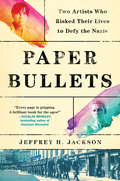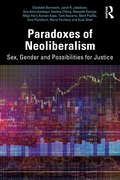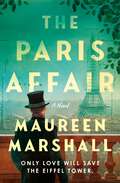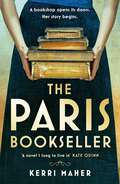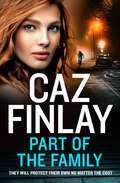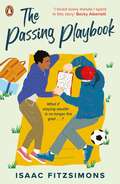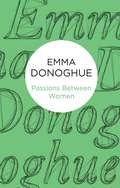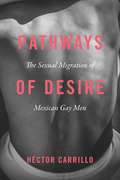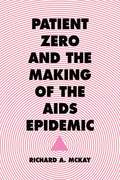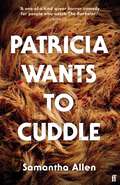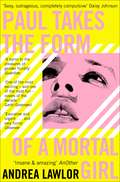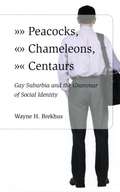- Table View
- List View
Pages for You: A Novel
by Sylvia Brownrigg‘A love letter written for a lost lover . . . mesmerizing’ Helen Dunmore, The TimesWhen Flannery Jansen arrives at university, she is totally unprepared for an encounter that will rock her existence. But when she comes across Anne Arden in a local diner, Flannery falls dramatically and desperately in love. Flannery is quickly embarrassed in the face of the older woman’s poise and sophistication, and under the gaze of those impossible green eyes, but slowly their paths intertwine, and soon Flannery becomes Anne’s eager student in life and love.Pages for You is the story of the beginning, blossoming and falling apart of that delirious love affair.
Paper Bullets: Two Artists Who Risked Their Lives to Defy the Nazis
by Jeffrey H. Jackson&“A Nazi resistance story like none you&’ve ever heard or read.&” —Hampton Sides, author of Ghost Soldiers and On Desperate Ground"Every page is gripping, and the amount of new research is nothing short of mind-boggling. A brilliant book for the ages!&” —Douglas Brinkley, author of American Moonshot A Stonewall Honor Book in Nonfiction Longlisted for the Carnegie Medal for Excellence in NonfictionPaper Bullets is the first book to tell the history of an audacious anti-Nazi campaign undertaken by an unlikely pair: two French women, Lucy Schwob and Suzanne Malherbe, who drew on their skills as Parisian avant-garde artists to write and distribute &“paper bullets&”—wicked insults against Hitler, calls to rebel, and subversive fictional dialogues designed to demoralize Nazi troops occupying their adopted home on the British Channel Island of Jersey. Devising their own PSYOPS campaign, they slipped their notes into soldier&’s pockets or tucked them inside newsstand magazines. Hunted by the secret field police, Lucy and Suzanne were finally betrayed in 1944, when the Germans imprisoned them, and tried them in a court martial, sentencing them to death for their actions. Ultimately they survived, but even in jail, they continued to fight the Nazis by reaching out to other prisoners and spreading a message of hope. Better remembered today by their artist names, Claude Cahun and Marcel Moore, the couple&’s actions were even more courageous because of who they were: lesbian partners known for cross-dressing and creating the kind of gender-bending work that the Nazis would come to call &“degenerate art.&” In addition, Lucy was half Jewish, and they had communist affiliations in Paris, where they attended political rallies with Surrealists and socialized with artists like Gertrude Stein.Paper Bullets is a compelling World War II story that has not been told before, about the galvanizing power of art, and of resistance.
Paradoxes of Neoliberalism: Sex, Gender and Possibilities for Justice (Social Justice)
by Elizabeth Bernstein Janet R. JakobsenFrom the rise of far-right regimes to the tumult of the COVID-19 pandemic, recent years have brought global upheaval as well as the sedimentation of longstanding social inequalities. Analyzing the complexities of the current political moment in different geographic regions, this book addresses the paradoxical persistence of neoliberal policies and practices, in order to ground the pursuit of a more just world. Engaging theories of decoloniality, racial capitalism, queer materialism, and social reproduction, this book demonstrates the centrality of sexual politics to neoliberalism, including both social relations and statecraft. Drawing on ethnographic case studies, the authors show that gender and sexuality may be the site for policies like those pertaining to sex trafficking, which bundle together economics and changes to the structure of the state. In other instances, sexual politics are crucial components of policies on issues ranging from the growth of financial services to migration. Tracing the role of sexual politics across different localities and through different political domains, this book delineates the paradoxical assemblage that makes up contemporary neoliberal hegemony. In addition to exploring contemporary social relations of neoliberal governance, exploitation, domination, and exclusion, the authors also consider gender and sexuality as forces that have shaped myriad forms of community-based activism and resistance, including local efforts to pursue new forms of social change. By tracing neoliberal paradoxes across global sites, the book delineates the multiple dimensions of economic and cultural restructuring that have characterized neoliberal regimes and emergent activist responses to them. This innovative analysis of the relationship between gender justice and political economy will appeal to: interdisciplinary scholars in social and cultural studies; legal and political theorists; and the wide range of readers who are concerned with contemporary questions of social justice.
Paradoxes of Neoliberalism: Sex, Gender and Possibilities for Justice (Social Justice)
by Janet Jakobsen and Elizabeth BernsteinFrom the rise of far-right regimes to the tumult of the COVID-19 pandemic, recent years have brought global upheaval as well as the sedimentation of longstanding social inequalities. Analyzing the complexities of the current political moment in different geographic regions, this book addresses the paradoxical persistence of neoliberal policies and practices, in order to ground the pursuit of a more just world. Engaging theories of decoloniality, racial capitalism, queer materialism, and social reproduction, this book demonstrates the centrality of sexual politics to neoliberalism, including both social relations and statecraft. Drawing on ethnographic case studies, the authors show that gender and sexuality may be the site for policies like those pertaining to sex trafficking, which bundle together economics and changes to the structure of the state. In other instances, sexual politics are crucial components of policies on issues ranging from the growth of financial services to migration. Tracing the role of sexual politics across different localities and through different political domains, this book delineates the paradoxical assemblage that makes up contemporary neoliberal hegemony. In addition to exploring contemporary social relations of neoliberal governance, exploitation, domination, and exclusion, the authors also consider gender and sexuality as forces that have shaped myriad forms of community-based activism and resistance, including local efforts to pursue new forms of social change. By tracing neoliberal paradoxes across global sites, the book delineates the multiple dimensions of economic and cultural restructuring that have characterized neoliberal regimes and emergent activist responses to them. This innovative analysis of the relationship between gender justice and political economy will appeal to: interdisciplinary scholars in social and cultural studies; legal and political theorists; and the wide range of readers who are concerned with contemporary questions of social justice.
The Paris Affair
by Maureen MarshallA queer historical romantic suspense novel about a young engineer working for Gustave Eiffel caught in a web of deceit that could destroy both him and the famous tower. Fin Tighe is clinging to respectability by his nail-bitten fingers. He may be the illegitimate son of an English earl, but he hasn&’t spoken to his father in a decade, and his engineer&’s salary is barely enough to support him and his cousin Aurelie. A dancer in the corps de ballet, Aurelie is at constant risk from groping, leering men who assume any dancer is a prostitute in training. And Fin&’s evenings spent in the clandestine gay community may be legal through a loophole in the Napoleonic Code, but they leave him vulnerable. So, when Fin&’s employer, Gustave Eiffel, announces that he needs additional investors to pay for his pet project, a 300-meter tower that will dominate the city&’s skyline, Fin jumps at the chance. If he raises enough money, the commission will earn him a fortune, and hopefully, some protection. Capricious stranger Gilbert Duhais appears to be a boon from the gods. Gilbert is handsome, wealthy, connected, and somehow privy to Fin&’s background. Gilbert persuades Fin to masquerade as his father&’s heir—which couldn&’t be further from the truth—and introduces him to every nouveau riche speculator in the city. Each provocative interaction heightens Fin's risk of exposure. But also brings Fin closer to his dream of financial security. When a dear friend of Fin&’s is murdered above a clandestine gay club, the stakes rise even higher. Fin must untangle the disparate threads of his past—and his current romantic gamble—before they become his noose.
The Paris Bookseller
by Kerri MaherINSPIRED BY THE WOMAN WHO FOUNDED SHAKESPEARE AND COMPANY'A vivid evocation of the famous female-owned Parisian bookshop... Kerri Maher writes a love letter to books, bookstores and booklovers everywhere' Kate Quinn, author of The Alice Network'I was completely enthralled' Natasha Lester, author of The Paris SecretThe captivating story of a trailblazing young woman who fought against incredible odds to bring one of the most important books of the twentieth century to the world. For readers of The Paris Library and The Paris Wife.PARIS, 1919.Young, bookish Sylvia Beach knows there is no greater city in the world than Paris. But when she opens an English-language bookshop on the bohemian Left Bank, Sylvia can't yet know she is making history.Many leading writers of the day, from Ernest Hemingway to Gertrude Stein, consider Shakespeare and Company a second home. Here some of the most profound literary friendships blossom - and none more so than between James Joyce and Sylvia herself.When Joyce's controversial novel Ulysses is banned, Sylvia determines to publish it through Shakespeare and Company. But the success and notoriety of publishing the most infamous book of the century comes at deep personal cost as Sylvia risks ruin, reputation and her heart in the name of the life-changing power of books...---'A compelling and fascinating look at the world-changing mavericks who bonded, bickered and triumphed in the realm of literature' Nuala O'Connor'A compelling portrait of a remarkable woman, who steps from the pages in all her charm, courage and vulnerability' Gill Paul'Intelligent, fierce and filled with reverence for a fascinating epoch in literary history... a delight for readers and writers' Whitney Scharer, author of The Age of Light'Lulls you into an interwar Parisian dream where love - be it romantic, friendly or even for a book - can be found on a quirky little street in the 6th' Kaia Alderson, author of Sisters in Arms
Part of the Family (Bad Blood #6)
by Caz FinlayThe brand new gangland thriller from Queen of Liverpool crime, Caz Finlay
The Passing Playbook
by Isaac FitzsimonsLove, Simon meets Friday Night Lights in this feelgood LGBTQ+ romance about a trans teen torn between standing up for his rights and staying stealth.'A sharply observant and vividly drawn debut. I loved every minute I spent in this story' - Becky AlbertalliFifteen-year-old Spencer Harris is a proud nerd, an awesome big brother and a Messi-in-training. He's also transgender. After transitioning at his old school leads to a year of bullying, Spencer gets a fresh start at Oakley, the most liberal private school in Ohio. At Oakley, Spencer seems to have it all: more accepting classmates, a decent shot at a starting position on the boy's soccer team, great new friends, and maybe even something more than friendship with one of his teammates. The problem is, no one at Oakley knows Spencer is trans - he's passing. So when a discriminatory law forces Spencer's coach to bench him after he discovers the 'F' on Spencer's birth certificate, Spencer has to make a choice: cheer his team on from the sidelines or publicly fight for his right to play, even if it means coming out to everyone - including the guy he's falling for.
Passions Between Women: British Lesbian Culture, 1668-1801
by Emma DonoghuePassions Between Women looks at stories of lesbian desires, acts and identities from the Restoration to the beginning of the nineteenth century. Far from being invisible, the figure of the woman who felt passion for women in this period was a subject of confusion and contradiction: she could be put in a freak show as a 'hermaphrodite', denounced as a 'tribade' or 'lesbian', revered as a 'romantic friend', jailed as a 'female husband' or gossiped about as a 'woman-lover', 'tommy' or 'Sapphist'. Through an examination of a wealth of new medical, legal and erotic source material, together with re-readings of classics of English literature, Emma Donoghue uncovers the astonishing range of lesbian and bisexual identities described in British texts between 1668 and 1801. Female pirates and spiritual mentors, chambermaids and queens, poets and prostitutes, country idylls and whipping clubs all take their place in an intriguing panorama of lesbian lives and loves.'Controversial, erotic and radical, Emma Donoghue's lesbian voyage of exploration outlines an astonishing spectrum of gender rebellion which creates a new map of eighteenth-century sexual territories and identities.' Patricia Duncker
Pathways of Desire: The Sexual Migration of Mexican Gay Men
by Héctor CarrilloWith Pathways of Desire, Héctor Carrillo brings us into the lives of Mexican gay men who have left their home country to pursue greater sexual autonomy and sexual freedom in the United States. The groundbreaking ethnographic study brings our attention to the full arc of these men’s migration experiences, from their upbringing in Mexican cities and towns, to their cross-border journeys, to their incorporation into urban gay communities in American cities, and their sexual and romantic relationships with American men. These men’s diverse and fascinating stories demonstrate the intertwining of sexual, economic, and familial motivations for migration. Further, Carrillo shows that sexual globalization must be regarded as a bidirectional, albeit uneven, process of exchange between countries in the global north and the global south. With this approach, Carrillo challenges the view that gay men from countries like Mexico would logically want to migrate to a “more sexually enlightened” country like the United States—a partial and limited understanding, given the dynamic character of sexuality in countries such as Mexico, which are becoming more accepting of sexual diversity. Pathways of Desire also provides a helpful analytical framework for the simultaneous consideration of structural and cultural factors in social scientific studies of sexuality. Carrillo explains the patterns of cross-cultural interaction that sexual migration generates and—at the most practical level—shows how the intricacies of cross-cultural sexual and romantic relations may affect the sexual health and HIV risk of transnational immigrant populations.
Pathways of Desire: The Sexual Migration of Mexican Gay Men
by Héctor CarrilloWith Pathways of Desire, Héctor Carrillo brings us into the lives of Mexican gay men who have left their home country to pursue greater sexual autonomy and sexual freedom in the United States. The groundbreaking ethnographic study brings our attention to the full arc of these men’s migration experiences, from their upbringing in Mexican cities and towns, to their cross-border journeys, to their incorporation into urban gay communities in American cities, and their sexual and romantic relationships with American men. These men’s diverse and fascinating stories demonstrate the intertwining of sexual, economic, and familial motivations for migration. Further, Carrillo shows that sexual globalization must be regarded as a bidirectional, albeit uneven, process of exchange between countries in the global north and the global south. With this approach, Carrillo challenges the view that gay men from countries like Mexico would logically want to migrate to a “more sexually enlightened” country like the United States—a partial and limited understanding, given the dynamic character of sexuality in countries such as Mexico, which are becoming more accepting of sexual diversity. Pathways of Desire also provides a helpful analytical framework for the simultaneous consideration of structural and cultural factors in social scientific studies of sexuality. Carrillo explains the patterns of cross-cultural interaction that sexual migration generates and—at the most practical level—shows how the intricacies of cross-cultural sexual and romantic relations may affect the sexual health and HIV risk of transnational immigrant populations.
Pathways of Desire: The Sexual Migration of Mexican Gay Men
by Héctor CarrilloWith Pathways of Desire, Héctor Carrillo brings us into the lives of Mexican gay men who have left their home country to pursue greater sexual autonomy and sexual freedom in the United States. The groundbreaking ethnographic study brings our attention to the full arc of these men’s migration experiences, from their upbringing in Mexican cities and towns, to their cross-border journeys, to their incorporation into urban gay communities in American cities, and their sexual and romantic relationships with American men. These men’s diverse and fascinating stories demonstrate the intertwining of sexual, economic, and familial motivations for migration. Further, Carrillo shows that sexual globalization must be regarded as a bidirectional, albeit uneven, process of exchange between countries in the global north and the global south. With this approach, Carrillo challenges the view that gay men from countries like Mexico would logically want to migrate to a “more sexually enlightened” country like the United States—a partial and limited understanding, given the dynamic character of sexuality in countries such as Mexico, which are becoming more accepting of sexual diversity. Pathways of Desire also provides a helpful analytical framework for the simultaneous consideration of structural and cultural factors in social scientific studies of sexuality. Carrillo explains the patterns of cross-cultural interaction that sexual migration generates and—at the most practical level—shows how the intricacies of cross-cultural sexual and romantic relations may affect the sexual health and HIV risk of transnational immigrant populations.
Pathways of Desire: The Sexual Migration of Mexican Gay Men
by Héctor CarrilloWith Pathways of Desire, Héctor Carrillo brings us into the lives of Mexican gay men who have left their home country to pursue greater sexual autonomy and sexual freedom in the United States. The groundbreaking ethnographic study brings our attention to the full arc of these men’s migration experiences, from their upbringing in Mexican cities and towns, to their cross-border journeys, to their incorporation into urban gay communities in American cities, and their sexual and romantic relationships with American men. These men’s diverse and fascinating stories demonstrate the intertwining of sexual, economic, and familial motivations for migration. Further, Carrillo shows that sexual globalization must be regarded as a bidirectional, albeit uneven, process of exchange between countries in the global north and the global south. With this approach, Carrillo challenges the view that gay men from countries like Mexico would logically want to migrate to a “more sexually enlightened” country like the United States—a partial and limited understanding, given the dynamic character of sexuality in countries such as Mexico, which are becoming more accepting of sexual diversity. Pathways of Desire also provides a helpful analytical framework for the simultaneous consideration of structural and cultural factors in social scientific studies of sexuality. Carrillo explains the patterns of cross-cultural interaction that sexual migration generates and—at the most practical level—shows how the intricacies of cross-cultural sexual and romantic relations may affect the sexual health and HIV risk of transnational immigrant populations.
Pathways of Desire: The Sexual Migration of Mexican Gay Men
by Héctor CarrilloWith Pathways of Desire, Héctor Carrillo brings us into the lives of Mexican gay men who have left their home country to pursue greater sexual autonomy and sexual freedom in the United States. The groundbreaking ethnographic study brings our attention to the full arc of these men’s migration experiences, from their upbringing in Mexican cities and towns, to their cross-border journeys, to their incorporation into urban gay communities in American cities, and their sexual and romantic relationships with American men. These men’s diverse and fascinating stories demonstrate the intertwining of sexual, economic, and familial motivations for migration. Further, Carrillo shows that sexual globalization must be regarded as a bidirectional, albeit uneven, process of exchange between countries in the global north and the global south. With this approach, Carrillo challenges the view that gay men from countries like Mexico would logically want to migrate to a “more sexually enlightened” country like the United States—a partial and limited understanding, given the dynamic character of sexuality in countries such as Mexico, which are becoming more accepting of sexual diversity. Pathways of Desire also provides a helpful analytical framework for the simultaneous consideration of structural and cultural factors in social scientific studies of sexuality. Carrillo explains the patterns of cross-cultural interaction that sexual migration generates and—at the most practical level—shows how the intricacies of cross-cultural sexual and romantic relations may affect the sexual health and HIV risk of transnational immigrant populations.
Patient Zero and the Making of the AIDS Epidemic
by Richard A. McKayThe search for a “patient zero”—popularly understood to be the first person infected in an epidemic—has been key to media coverage of major infectious disease outbreaks for more than three decades. Yet the term itself did not exist before the emergence of the HIV/AIDS epidemic in the 1980s. How did this idea so swiftly come to exert such a strong grip on the scientific, media, and popular consciousness? In Patient Zero, Richard A. McKay interprets a wealth of archival sources and interviews to demonstrate how this seemingly new concept drew upon centuries-old ideas—and fears—about contagion and social disorder. McKay presents a carefully documented and sensitively written account of the life of Gaétan Dugas, a gay man whose skin cancer diagnosis in 1980 took on very different meanings as the HIV/AIDS epidemic developed—and who received widespread posthumous infamy when he was incorrectly identified as patient zero of the North American outbreak. McKay shows how investigators from the US Centers for Disease Control inadvertently created the term amid their early research into the emerging health crisis; how an ambitious journalist dramatically amplified the idea in his determination to reframe national debates about AIDS; and how many individuals grappled with the notion of patient zero—adopting, challenging and redirecting its powerful meanings—as they tried to make sense of and respond to the first fifteen years of an unfolding epidemic. With important insights for our interconnected age, Patient Zero untangles the complex process by which individuals and groups create meaning and allocate blame when faced with new disease threats. What McKay gives us here is myth-smashing revisionist history at its best.
Patient Zero and the Making of the AIDS Epidemic
by Richard A. McKayNow an award-winning documentary feature film The search for a “patient zero”—popularly understood to be the first person infected in an epidemic—has been key to media coverage of major infectious disease outbreaks for more than three decades. Yet the term itself did not exist before the emergence of the HIV/AIDS epidemic in the 1980s. How did this idea so swiftly come to exert such a strong grip on the scientific, media, and popular consciousness? In Patient Zero, Richard A. McKay interprets a wealth of archival sources and interviews to demonstrate how this seemingly new concept drew upon centuries-old ideas—and fears—about contagion and social disorder. McKay presents a carefully documented and sensitively written account of the life of Gaétan Dugas, a gay man whose skin cancer diagnosis in 1980 took on very different meanings as the HIV/AIDS epidemic developed—and who received widespread posthumous infamy when he was incorrectly identified as patient zero of the North American outbreak. McKay shows how investigators from the US Centers for Disease Control inadvertently created the term amid their early research into the emerging health crisis; how an ambitious journalist dramatically amplified the idea in his determination to reframe national debates about AIDS; and how many individuals grappled with the notion of patient zero—adopting, challenging and redirecting its powerful meanings—as they tried to make sense of and respond to the first fifteen years of an unfolding epidemic. With important insights for our interconnected age, Patient Zero untangles the complex process by which individuals and groups create meaning and allocate blame when faced with new disease threats. What McKay gives us here is myth-smashing revisionist history at its best.
Patient Zero and the Making of the AIDS Epidemic
by Richard A. McKayNow an award-winning documentary feature film The search for a “patient zero”—popularly understood to be the first person infected in an epidemic—has been key to media coverage of major infectious disease outbreaks for more than three decades. Yet the term itself did not exist before the emergence of the HIV/AIDS epidemic in the 1980s. How did this idea so swiftly come to exert such a strong grip on the scientific, media, and popular consciousness? In Patient Zero, Richard A. McKay interprets a wealth of archival sources and interviews to demonstrate how this seemingly new concept drew upon centuries-old ideas—and fears—about contagion and social disorder. McKay presents a carefully documented and sensitively written account of the life of Gaétan Dugas, a gay man whose skin cancer diagnosis in 1980 took on very different meanings as the HIV/AIDS epidemic developed—and who received widespread posthumous infamy when he was incorrectly identified as patient zero of the North American outbreak. McKay shows how investigators from the US Centers for Disease Control inadvertently created the term amid their early research into the emerging health crisis; how an ambitious journalist dramatically amplified the idea in his determination to reframe national debates about AIDS; and how many individuals grappled with the notion of patient zero—adopting, challenging and redirecting its powerful meanings—as they tried to make sense of and respond to the first fifteen years of an unfolding epidemic. With important insights for our interconnected age, Patient Zero untangles the complex process by which individuals and groups create meaning and allocate blame when faced with new disease threats. What McKay gives us here is myth-smashing revisionist history at its best.
Patient Zero and the Making of the AIDS Epidemic
by Richard A. McKayNow an award-winning documentary feature film The search for a “patient zero”—popularly understood to be the first person infected in an epidemic—has been key to media coverage of major infectious disease outbreaks for more than three decades. Yet the term itself did not exist before the emergence of the HIV/AIDS epidemic in the 1980s. How did this idea so swiftly come to exert such a strong grip on the scientific, media, and popular consciousness? In Patient Zero, Richard A. McKay interprets a wealth of archival sources and interviews to demonstrate how this seemingly new concept drew upon centuries-old ideas—and fears—about contagion and social disorder. McKay presents a carefully documented and sensitively written account of the life of Gaétan Dugas, a gay man whose skin cancer diagnosis in 1980 took on very different meanings as the HIV/AIDS epidemic developed—and who received widespread posthumous infamy when he was incorrectly identified as patient zero of the North American outbreak. McKay shows how investigators from the US Centers for Disease Control inadvertently created the term amid their early research into the emerging health crisis; how an ambitious journalist dramatically amplified the idea in his determination to reframe national debates about AIDS; and how many individuals grappled with the notion of patient zero—adopting, challenging and redirecting its powerful meanings—as they tried to make sense of and respond to the first fifteen years of an unfolding epidemic. With important insights for our interconnected age, Patient Zero untangles the complex process by which individuals and groups create meaning and allocate blame when faced with new disease threats. What McKay gives us here is myth-smashing revisionist history at its best.
Patient Zero and the Making of the AIDS Epidemic
by Richard A. McKayNow an award-winning documentary feature film The search for a “patient zero”—popularly understood to be the first person infected in an epidemic—has been key to media coverage of major infectious disease outbreaks for more than three decades. Yet the term itself did not exist before the emergence of the HIV/AIDS epidemic in the 1980s. How did this idea so swiftly come to exert such a strong grip on the scientific, media, and popular consciousness? In Patient Zero, Richard A. McKay interprets a wealth of archival sources and interviews to demonstrate how this seemingly new concept drew upon centuries-old ideas—and fears—about contagion and social disorder. McKay presents a carefully documented and sensitively written account of the life of Gaétan Dugas, a gay man whose skin cancer diagnosis in 1980 took on very different meanings as the HIV/AIDS epidemic developed—and who received widespread posthumous infamy when he was incorrectly identified as patient zero of the North American outbreak. McKay shows how investigators from the US Centers for Disease Control inadvertently created the term amid their early research into the emerging health crisis; how an ambitious journalist dramatically amplified the idea in his determination to reframe national debates about AIDS; and how many individuals grappled with the notion of patient zero—adopting, challenging and redirecting its powerful meanings—as they tried to make sense of and respond to the first fifteen years of an unfolding epidemic. With important insights for our interconnected age, Patient Zero untangles the complex process by which individuals and groups create meaning and allocate blame when faced with new disease threats. What McKay gives us here is myth-smashing revisionist history at its best.
Patient Zero and the Making of the AIDS Epidemic
by Richard A. McKayNow an award-winning documentary feature film The search for a “patient zero”—popularly understood to be the first person infected in an epidemic—has been key to media coverage of major infectious disease outbreaks for more than three decades. Yet the term itself did not exist before the emergence of the HIV/AIDS epidemic in the 1980s. How did this idea so swiftly come to exert such a strong grip on the scientific, media, and popular consciousness? In Patient Zero, Richard A. McKay interprets a wealth of archival sources and interviews to demonstrate how this seemingly new concept drew upon centuries-old ideas—and fears—about contagion and social disorder. McKay presents a carefully documented and sensitively written account of the life of Gaétan Dugas, a gay man whose skin cancer diagnosis in 1980 took on very different meanings as the HIV/AIDS epidemic developed—and who received widespread posthumous infamy when he was incorrectly identified as patient zero of the North American outbreak. McKay shows how investigators from the US Centers for Disease Control inadvertently created the term amid their early research into the emerging health crisis; how an ambitious journalist dramatically amplified the idea in his determination to reframe national debates about AIDS; and how many individuals grappled with the notion of patient zero—adopting, challenging and redirecting its powerful meanings—as they tried to make sense of and respond to the first fifteen years of an unfolding epidemic. With important insights for our interconnected age, Patient Zero untangles the complex process by which individuals and groups create meaning and allocate blame when faced with new disease threats. What McKay gives us here is myth-smashing revisionist history at its best.
Patricia Wants to Cuddle: A Novel
by Samantha AllenThis week on The CatchThe Final Four are headed to a remote, luxurious island, hoping to score some one-on-one time with America's most eligible bachelor.Tensions are high and emotions are running hot as the contestants compete for the attention of the Catch, and of the cameras. What they don't realise is that they've already been noticed by someone else.Get ready for the biggest - and bloodiest - Elimination Event of the season.What readers are saying'THIS WAS INSANE IN THE BEST WAY I AM OBSESSED''A gloriously bonkers book''This book sucked me in and I couldn't put it down!''One of my favorite books this year!!''It's a wild ride.''Funny and smart, it's also surprisingly tender.''It was a genuine page turner.'
Paul Takes the Form of A Mortal Girl
by Andrea LawlorIt’s 1993 and Paul Polydoris tends bar at the only gay club in a university town thrumming with politics and partying. He studies queer theory, has a lesbian best friend, makes zines, and is a flâneur with a rich dating life. But Paul’s also got a secret: he’s a shapeshifter. Oscillating wildly from Riot Grrrl to leather cub, Women’s Studies major to trade, Paul transforms his body at will in a series of adventures that take him from Iowa City to Boystown to Provincetown and finally to San Francisco – a journey through the deep queer archives of struggle and pleasure. Andrea Lawlor’s debut novel offers a speculative history of early 90s identity politics during the heyday of ACT UP and Queer Nation. Paul Takes the Form of A Mortal Girl is a riotous, razor-sharp bildungsroman whose hero/ine wends his way through a world gutted by loss, pulsing with music, and opening into an array of intimacy and connections.
Peacocks, Chameleons, Centaurs: Gay Suburbia and the Grammar of Social Identity
by Wayne BrekhusWhat does it mean to be a gay man living in the suburbs? Do you identify primarily as gay, or suburban, or some combination of the two? For that matter, how does anyone decide what his or her identity is? In this first-ever ethnography of American gay suburbanites, Wayne H. Brekhus demonstrates that who one is depends at least in part on where and when one is. For many urban gay men, being homosexual is key to their identity because they live, work, and socialize in almost exclusively gay circles. Brekhus calls such men "lifestylers" or peacocks. Chameleons or "commuters," on the other hand, live and work in conventional suburban settings, but lead intense gay social and sexual lives outside the suburbs. Centaurs, meanwhile, or "integrators," mix typical suburban jobs and homes with low-key gay social and sexual activities. In other words, lifestylers see homosexuality as something you are, commuters as something you do, and integrators as part of yourself. Ultimately, Brekhus shows that lifestyling, commuting, and integrating embody competing identity strategies that occur not only among gay men but across a broad range of social categories. What results, then, is an innovative work that will interest sociologists, psychologists, anthropologists, and students of gay culture.
Peacocks, Chameleons, Centaurs: Gay Suburbia and the Grammar of Social Identity
by Wayne BrekhusWhat does it mean to be a gay man living in the suburbs? Do you identify primarily as gay, or suburban, or some combination of the two? For that matter, how does anyone decide what his or her identity is? In this first-ever ethnography of American gay suburbanites, Wayne H. Brekhus demonstrates that who one is depends at least in part on where and when one is. For many urban gay men, being homosexual is key to their identity because they live, work, and socialize in almost exclusively gay circles. Brekhus calls such men "lifestylers" or peacocks. Chameleons or "commuters," on the other hand, live and work in conventional suburban settings, but lead intense gay social and sexual lives outside the suburbs. Centaurs, meanwhile, or "integrators," mix typical suburban jobs and homes with low-key gay social and sexual activities. In other words, lifestylers see homosexuality as something you are, commuters as something you do, and integrators as part of yourself. Ultimately, Brekhus shows that lifestyling, commuting, and integrating embody competing identity strategies that occur not only among gay men but across a broad range of social categories. What results, then, is an innovative work that will interest sociologists, psychologists, anthropologists, and students of gay culture.
Peacocks, Chameleons, Centaurs: Gay Suburbia and the Grammar of Social Identity
by Wayne BrekhusWhat does it mean to be a gay man living in the suburbs? Do you identify primarily as gay, or suburban, or some combination of the two? For that matter, how does anyone decide what his or her identity is? In this first-ever ethnography of American gay suburbanites, Wayne H. Brekhus demonstrates that who one is depends at least in part on where and when one is. For many urban gay men, being homosexual is key to their identity because they live, work, and socialize in almost exclusively gay circles. Brekhus calls such men "lifestylers" or peacocks. Chameleons or "commuters," on the other hand, live and work in conventional suburban settings, but lead intense gay social and sexual lives outside the suburbs. Centaurs, meanwhile, or "integrators," mix typical suburban jobs and homes with low-key gay social and sexual activities. In other words, lifestylers see homosexuality as something you are, commuters as something you do, and integrators as part of yourself. Ultimately, Brekhus shows that lifestyling, commuting, and integrating embody competing identity strategies that occur not only among gay men but across a broad range of social categories. What results, then, is an innovative work that will interest sociologists, psychologists, anthropologists, and students of gay culture.

